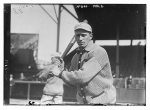McMurray: An interview with Rob Neyer on the Deadball Era
Editor’s note: This article first appeared in the SABR Deadball Era Research Committee’s “The Inside Game” newsletter in June 2014. To learn more about the Deadball Era Research Committee, click here.
By John McMurray
 A SABR member since 1984, Rob Neyer has written six books on baseball and was a prominent baseball columnist for ESPN.com for almost 15 years, leaving in early 2011 for SBNation.com. In 2014, he joined FoxSports.com as their Senior Baseball Editor.
A SABR member since 1984, Rob Neyer has written six books on baseball and was a prominent baseball columnist for ESPN.com for almost 15 years, leaving in early 2011 for SBNation.com. In 2014, he joined FoxSports.com as their Senior Baseball Editor.
Neyer, who began his career while working with Bill James, has been a prominent advocate of using sabermetrics to evaluate player performance and has written several articles discussing candidates for the Baseball Hall of Fame.
He offered his perspective to The Inside Game on several topics relating to the Deadball Era:
Question: What is your opinion about the practicality of voters continuing to consider Deadball Era players for the Hall of Fame, considering that there is no one living who has seen any of them play?
Answer: I don’t know that it should matter much if anyone alive has ever seen them. The great majority of people who are alive now didn’t see Ron Santo play, yet it made sense to a lot of people to put him in the Hall of Fame. It made sense to me. I don’t believe in a statute of limitations.
Now, you could argue, and probably people have, that if someone gets chance after chance after chance via whatever avenue and isn’t elected, it becomes sort of self-defeating in a way, or perhaps pointless to keep trying. But I think if I were running the Hall of Fame, I would try to figure out a process — I haven’t even begun to think what that would look like — but I would have some sort of process that would allow for consideration of any outstanding candidate, regardless of when he played.
Q: What about candidates like Deacon White or Hank O’Day, who were elected in 2013? The 16-member Pre-Integration Era Committee obviously decided that each was worthy of the Hall of Fame, but others could counter by arguing that the Hall of Fame could still tell the story of baseball without them being included.
A: You could make that argument, and I think it’s a valid point. To me, it gets back to the question of why the Hall of Fame exists. Does it exist to tell a story? Does it exist to highlight the best players of the era? One thing the Hall of Fame has never really done — at least not to my satisfaction — is to explain what its role is. We know the role of the museum is to educate the public and to preserve the history. I’m pretty clear about that. I don’t know that they’ve ever been particularly clear about the role of the Hall of Fame itself and what the plaques signify. Maybe the Hall of Fame likes it that way. That sorts of leads us (i.e, each of us, individually) to decide what it should be. I think it should be for the best players, and there are a lot of players in there who shouldn’t be. And there are a few who aren’t in there, whom I think should be.
Q: Considering the growth of advanced metrics to assess player performance, are there some potential Hall of Fame candidates from the Deadball Era whom you now view differently because you saw new statistical measures which you hadn’t seen before?
 A: Off the top of my head, I think that Sherry Magee is the one player whom I had no idea until recently of just how good he was. I think we really have given short-shrift to some outstanding hitters from that era. If they didn’t all hit .360 or something, like Cobb, we just sort of ignore them. Magee didn’t have a particularly long career, but very few players in those days had long careers. I would love to see some data on this, but it seems to me like the injury risk was just so high in those days that, aside from Cobb, Lajoie, Wagner, and maybe Eddie Collins — the ones who basically had all the big seasons — there really wasn’t much room for anyone else. And part of the reason was because a lot of players just couldn’t stay healthy.
A: Off the top of my head, I think that Sherry Magee is the one player whom I had no idea until recently of just how good he was. I think we really have given short-shrift to some outstanding hitters from that era. If they didn’t all hit .360 or something, like Cobb, we just sort of ignore them. Magee didn’t have a particularly long career, but very few players in those days had long careers. I would love to see some data on this, but it seems to me like the injury risk was just so high in those days that, aside from Cobb, Lajoie, Wagner, and maybe Eddie Collins — the ones who basically had all the big seasons — there really wasn’t much room for anyone else. And part of the reason was because a lot of players just couldn’t stay healthy.
So it was a different time. With Jimmy Sheckard, Magee, and Bill Dahlen, I think those players really haven’t really gotten their due over the years. Now, there aren’t many I would put in that category. In other words, there really aren’t that many guys who are missing in the Hall of Fame from the Deadball Era. But I do think those few players who did put up big numbers for at least six or eight or ten years, we should talk about them more.
Q: The best Deadball Era players who are not in the Hall of Fame may have been good players — like Magee and Sheckard — but they were not key cogs on championship teams. Is it reasonable to infer that the voters may already have already elected all of the worthy candidates from the Deadball Era?
A: Maybe the voters have. It seems to me that the math would suggest that there probably is a player or two from that era who deserves to be elected because it just seems unlikely that we would have gotten all of them. And it is also tough to look at managers from those days to know who was really doing the managing, the general managing, and all that.
Q: How would you weigh the merits of potential Deadball Era Hall of Fame candidates versus candidates from the 19th century?
A: I’m generally ignorant of the 19th century and the early Deadball Era, and, if I am, I suspect that the vast majority of people who do what I do are also ignorant, and that hasn’t helped. To a large degree, our memories sort of begin with the players who are in The Glory of Their Times because they were the oldest who were interviewed and who we were able to memorialize. Of course, we know that Marquard wouldn’t be in the Hall of Fame without that book.
Q: What appeal do the players of the Deadball Era hold for you, as a columnist who most often writes about contemporary players?
A: It has always been difficult for me to relate to the Deadball Era for all of the obvious reasons. We don’t have the film or the color photography and very few interviews, at least ones that have been published. At the same time, I love reading about that era. For me, like a lot of people — and I’m not proud of this at all —baseball basically starts for me with the American League joining the National League. That’s when it really becomes real to me. Maybe it’s just because there’s a “19” in front of the year instead of an “18.” I don’t know what it is. The 19th century has never really captured my interest. I don’t really know why, it just hasn’t. You know, the Deadball Era begins with 1901 and 1902, then the World Series starts, you have Ty Cobb, et cetera, et cetera. As a result, my baseball knowledge begins around then, and I’ve obviously read more about the Deadball Era than I have about the 19th century.
Q: To what extent does the ability to recognize the game during the Deadball Era and to compare it easily to today’s game play a role in the period’s appeal for you?
A: I think that’s it. It has often been said that one of the attractions of baseball is that we could go back to the game in 1912 or 1935 or whatever, and it would basically be the game we know and understand. And the further you go back, especially into the 19th century and as the pitching distance becomes different, the less it becomes the game that we know. Yes, we would recognize baseball in 1882 as being baseball, but I think it would be harder to relate to than it would be even 20 years later. Basically, the further back you go, the messier it gets. And, I think, messy is hard. You know, John Thorn embraces it, but many of us, including me, have a tough time with it. We stick with what we understand and what is accessible.
I think it comes back to the fact that it is a recognizable game during the Deadball Era. And we do have recognizable figures: we have Ty Cobb, whom everybody knows. We also have Honus Wagner and Walter Johnson, which lends credence to the idea that the Deadball Era is as far back as we can go with clarity. And we want to go back because an appealing thing about baseball is the nostalgia and the history. We want to go back, but we don’t want to go back too far. In that sense, to me the Deadball Era is an excellent starting point.
JOHN McMURRAY is chair of SABR’s Deadball Era Research Committee. Contact him at deadball@sabr.org.
Originally published: May 28, 2014. Last Updated: May 28, 2014.


